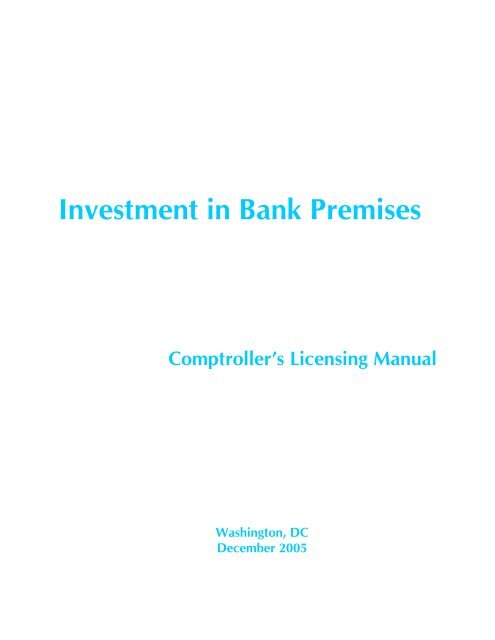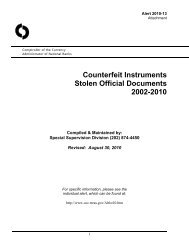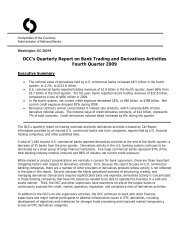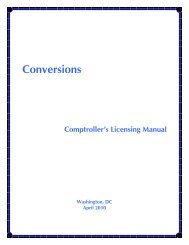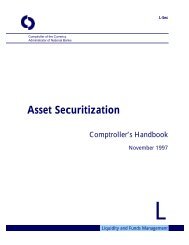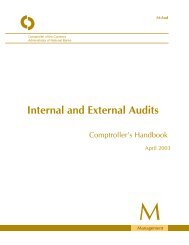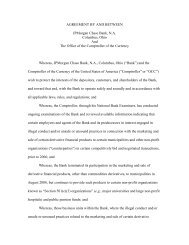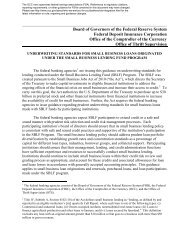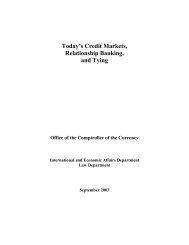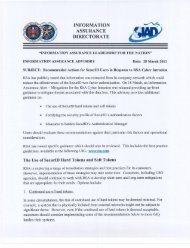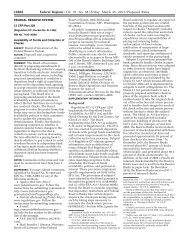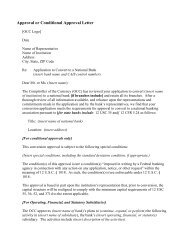Investment in Bank Premises - OCC
Investment in Bank Premises - OCC
Investment in Bank Premises - OCC
You also want an ePaper? Increase the reach of your titles
YUMPU automatically turns print PDFs into web optimized ePapers that Google loves.
application. The <strong>OCC</strong> will <strong>in</strong>clude the approval for the <strong>in</strong>vestment and anyappropriate conditions <strong>in</strong> its decision letter for the pr<strong>in</strong>cipal application.Key PoliciesA bank may acquire and hold bank premises by any reasonable and prudent means,<strong>in</strong>clud<strong>in</strong>g ownership <strong>in</strong> fee (refer to the Glossary), a leasehold estate, or an <strong>in</strong>terest<strong>in</strong> a cooperative. The bank may hold such property directly or through one or moresubsidiaries. A bank premises subsidiary may be organized as a corporation, apartnership, or similar entity; for example, a limited liability company.The amount <strong>in</strong>vested <strong>in</strong> bank premises and fixed assets generally is considered to bea matter with<strong>in</strong> the discretion of bank management. Fixed assets <strong>in</strong>clude furniture,fixtures, data process<strong>in</strong>g, and other equipment necessary for the transaction of thebank’s bus<strong>in</strong>ess.Decision CriteriaWhen analyz<strong>in</strong>g an application for an excess <strong>in</strong>vestment <strong>in</strong> bank premises, the <strong>OCC</strong>will consider:• Consistency with safe and sound bank<strong>in</strong>g practices and <strong>OCC</strong> policy.• Whether any transaction <strong>in</strong>volves bank <strong>in</strong>siders, and if so, whether the terms arethe same as those prevail<strong>in</strong>g at the time for comparable transactions with<strong>in</strong>dependent parties.• The reasonableness of the amount of bank premises and the annual expendituresrequired to carry them relative to the bank’s total capital structure and the natureand volume of operations.• The effect of the <strong>in</strong>vestment on future earn<strong>in</strong>gs.The <strong>OCC</strong> will consider deny<strong>in</strong>g a request for an additional <strong>in</strong>vestment <strong>in</strong> bankpremises when:• The additional <strong>in</strong>vestment would have a material negative effect on the bank’searn<strong>in</strong>gs, capital, or liquidity.• The board of directors and management have not demonstrated a reasonableneed for the additional <strong>in</strong>vestment.• The additional <strong>in</strong>vestment <strong>in</strong>volves an unsafe and unsound transaction with abank <strong>in</strong>sider.Special ConditionsThe <strong>OCC</strong> may impose appropriate special conditions for an approval of anadditional bank premises <strong>in</strong>vestment, if it determ<strong>in</strong>es that they are necessary orappropriate to protect the safety and soundness of the bank; to prevent conflicts of2
<strong>in</strong>terest; or to further other supervisory or policy considerations. Such conditions<strong>in</strong>clude, but are not limited to:• Ma<strong>in</strong>tenance of adequate capital levels.• Development of specific plans to improve earn<strong>in</strong>gs.• Development of specific plans to improve liquidity.• A statement that the <strong>in</strong>vestment <strong>in</strong> bank premises may not be <strong>in</strong>creased furtherwithout prior <strong>OCC</strong> approval if the result<strong>in</strong>g total exceeds the bank’s capitalstock.• Submission of an appraisal to support the transaction.The <strong>OCC</strong> may apply these conditions as “conditions imposed <strong>in</strong> writ<strong>in</strong>g” with<strong>in</strong> themean<strong>in</strong>g of 12 USC 1818. The conditions rema<strong>in</strong> <strong>in</strong> effect after the effective date orconsummation date of an approved transaction or activity and cont<strong>in</strong>ue until the<strong>OCC</strong> removes them.Application and NoticeGenerally, a bank need not obta<strong>in</strong> <strong>OCC</strong>’s prior approval to <strong>in</strong>vest <strong>in</strong>: (1) bankpremises; (2) the stock, bonds, debentures, or other such obligations of anycorporation hold<strong>in</strong>g the premises of such bank; or (3) loans to or on the security ofthe stock of any such corporation. However, prior approval is required if theaggregate of all such <strong>in</strong>vestments and loans, together with any <strong>in</strong>debtedness<strong>in</strong>curred by any such corporation that is an affiliate (see Glossary) of the bank,exceeds the amount of the bank’s capital stock. The <strong>OCC</strong>’s approval for a specifiedamount rema<strong>in</strong>s valid up to that amount until the <strong>OCC</strong> notifies the bank otherwise.The bank will file with the appropriate supervisory office, unless the <strong>in</strong>vestment <strong>in</strong>bank premises is comb<strong>in</strong>ed with a corporate application for another transaction.(See Procedures section of this booklet for specific guidance.) Also a bank thatmeets certa<strong>in</strong> criteria as discussed below may file an after-the-fact notice with theappropriate supervisory office rather than obta<strong>in</strong> prior approval.After-the-Fact NoticeIn certa<strong>in</strong> <strong>in</strong>stances, a bank that wishes to <strong>in</strong>vest an amount <strong>in</strong> excess of its capitalstock <strong>in</strong> its bank premises may proceed without seek<strong>in</strong>g prior <strong>OCC</strong> approval. Abank that has a composite CAMELS 1 or 2 rat<strong>in</strong>g may notify the appropriatesupervisory office <strong>in</strong> writ<strong>in</strong>g with<strong>in</strong> 30 days follow<strong>in</strong>g any transaction that <strong>in</strong>creasesits aggregate bank premises <strong>in</strong>vestment to an amount that is <strong>in</strong> excess of its capitalstock, but is not more than 150 percent of its capital and surplus. The bank must bewell capitalized as def<strong>in</strong>ed at 12 CFR 6.4(b)(1) and cont<strong>in</strong>ue to be well capitalized,after the <strong>in</strong>vestment or loan is made to qualify for the after-the-fact notice process.The bank must <strong>in</strong>clude <strong>in</strong> its notice a description of the bank’s <strong>in</strong>vestment or loan.A bank must notify the <strong>OCC</strong> each time a purchase raises the bank premises<strong>in</strong>vestment above the capital stock amount but is with<strong>in</strong> the 150 percent safe harboramount.3
Standard Process<strong>in</strong>gA bank that does not qualify for an after-the-fact notice must submit a writtenapplication to the appropriate supervisory office to request approval to exceed theamount of its capital stock. If the fil<strong>in</strong>g is comb<strong>in</strong>ed with a corporate applicationand received <strong>in</strong> Licens<strong>in</strong>g, Licens<strong>in</strong>g will forward the bank premises portion to theappropriate supervisory office for a decision.A bank may choose to apply on either a transaction-by-transaction or a specifiedamount basis that is designed to accommodate future transactions. The bank mustprovide:• A description of the present bank premises <strong>in</strong>vestment.• The amount of the <strong>in</strong>vestment that the bank <strong>in</strong>tends to make and whether it<strong>in</strong>volves a transaction with an <strong>in</strong>sider.• The amount by which the <strong>in</strong>vestment or the specified amount will exceed itscapital stock.• The bus<strong>in</strong>ess reason for the requested level of <strong>in</strong>vestment.The bank also may wish to discuss its present annual and projected future earn<strong>in</strong>gs<strong>in</strong> the application. A bank’s request for a higher specified amount should relate toits bus<strong>in</strong>ess reason or strategic plan. A bank may file a s<strong>in</strong>gle application for aspecified amount that will establish an approved amount of bank premises andelim<strong>in</strong>ate the need to file repeated after-the-fact notices for a series of premises<strong>in</strong>vestments. This specified amount rema<strong>in</strong>s valid until the <strong>OCC</strong> notifies the bankotherwise.Tim<strong>in</strong>g ConsiderationsThe <strong>OCC</strong> considers an application approved as of the 30th day after it receives thefil<strong>in</strong>g, unless the <strong>OCC</strong> notifies the bank prior to that date that the fil<strong>in</strong>g presents asignificant supervisory or compliance concern or raises a significant legal or policyissue.Specific Requirements<strong>Investment</strong> <strong>in</strong> Real EstateA national bank may <strong>in</strong>vest <strong>in</strong> real estate necessary for the transaction of itsbus<strong>in</strong>ess. This real estate <strong>in</strong>cludes:• <strong>Premises</strong> that are owned or occupied (or to be occupied, if under construction)by the bank, its branches, or its consolidated subsidiaries.• Real estate acquired and <strong>in</strong>tended, <strong>in</strong> good faith, for use <strong>in</strong> future expansion.4
• Park<strong>in</strong>g facilities used by customers or employees of the bank, its branches, andits consolidated subsidiaries.• Residential property for the use of bank officers or employees who are: (1)located <strong>in</strong> remote areas <strong>in</strong> which suitable hous<strong>in</strong>g at a reasonable price is oftenunavailable; or (2) temporarily assigned to a foreign country, <strong>in</strong>clud<strong>in</strong>g foreignnationals temporarily assigned to the United States.• Property for the use of bank officers, employees, or customers, or for thetemporary lodg<strong>in</strong>g of such persons <strong>in</strong> areas <strong>in</strong> which suitable commerciallodg<strong>in</strong>g is often unavailable, provided that the purchase and operation of theproperty qualifies as a deductible bus<strong>in</strong>ess expense for federal tax purposes.In addition, to facilitate the efficient use of bank personnel, a bank may purchasethe residence of an employee who has been transferred to another area to spare theemployee a loss <strong>in</strong> the prevail<strong>in</strong>g real estate market. The bank must arrange forearly divestment of the property’s title (12 CFR 7.1000(d)(2)).Transactions with InsidersExamples of bank <strong>in</strong>sider (see Glossary) transactions <strong>in</strong>clude: (1) a direct purchase ofreal estate from an <strong>in</strong>sider; (2) leas<strong>in</strong>g property that is owned, directly or <strong>in</strong>directly,by an <strong>in</strong>sider; (3) transactions <strong>in</strong> which the proceeds benefit, or are transferred to, an<strong>in</strong>sider; and, (4) situations <strong>in</strong> which an <strong>in</strong>sider will benefit from the transaction (forexample, an <strong>in</strong>sider owns an adjacent park<strong>in</strong>g facility or provides janitorial or otherservices to the property). The <strong>OCC</strong> expects full disclosure to all directors of anymaterial arrangement with an <strong>in</strong>sider.If the <strong>in</strong>vestment <strong>in</strong>volves a bank <strong>in</strong>sider, the bank must provide additional<strong>in</strong>formation about the terms of the transaction; for example:• The name of the bank <strong>in</strong>sider and his/her relationship to the bank.• A description of how the bank determ<strong>in</strong>ed the fairness of the terms, which may<strong>in</strong>clude provid<strong>in</strong>g a copy of an <strong>in</strong>dependent appraisal or other evidence of thefairness of the transaction.• A copy of the board of directors’ resolution approv<strong>in</strong>g the transaction thatreflects the bank <strong>in</strong>sider’s abstention from the discussion and vot<strong>in</strong>g.• A copy of the executed lease or purchase agreement (cont<strong>in</strong>gent upon <strong>OCC</strong>approval).• An account<strong>in</strong>g determ<strong>in</strong>ation of whether a lease should be capitalized.• A justification of the expenditure.5
Account<strong>in</strong>gDepreciationThe <strong>OCC</strong> calculates a bank’s total <strong>in</strong>vestment <strong>in</strong> bank premises us<strong>in</strong>g net bookvalue. The bank must deduct accumulated depreciation when calculat<strong>in</strong>g the total<strong>in</strong>vestment for 12 USC 371d purposes.Capitalized LeasesFASB Statement No. 13 states that a bank must account for a lease as a capital lease,if the lease meets any one of the follow<strong>in</strong>g conditions:• Ownership of the property is transferred automatically to the lessee at the end ofthe lease term.• The lease conta<strong>in</strong>s a barga<strong>in</strong> purchase option.• The lease term represents at least 75 percent of the estimated economic life ofthe lease property.• The present value of the m<strong>in</strong>imum lease payments at the beg<strong>in</strong>n<strong>in</strong>g of the leaseterm is 90 percent or more of the fair value of the leased property to the lessor atthe <strong>in</strong>ception of the lease, less any related <strong>in</strong>vestment tax credit that the lessorreta<strong>in</strong>s and expects to realize.In a capitalized lease situation, the bank would account for the capital lease as anasset f<strong>in</strong>anced with a debt obligation. If none of the conditions listed above arepresent, the lease is accounted for as an operat<strong>in</strong>g lease, and the bank wouldnormally expense the lease payments when <strong>in</strong>curred. The call report <strong>in</strong>structions<strong>in</strong>clude detailed <strong>in</strong>formation on lease account<strong>in</strong>g.Municipal Park<strong>in</strong>g LotsExpenditures toward the acquisition and operation of municipal park<strong>in</strong>g lotsord<strong>in</strong>arily represent a bus<strong>in</strong>ess expense that the bank should charge off rather thantreat as an <strong>in</strong>vestment <strong>in</strong> bank premises.AppraisalThe <strong>OCC</strong> considers the sale, lease, purchase, <strong>in</strong>vestment <strong>in</strong>, or exchange of bankpremises <strong>in</strong>volv<strong>in</strong>g real property a real estate-related transaction under 12 CFR34.42(i). Unless specifically exempted <strong>in</strong> 12 CFR 34.43(a), the <strong>OCC</strong> requires aconform<strong>in</strong>g appraisal for such transactions.Options to PurchaseThe <strong>OCC</strong> does not consider an unexercised option to purchase bank premises orstock <strong>in</strong> a corporation hold<strong>in</strong>g bank premises as an <strong>in</strong>vestment <strong>in</strong> bank premises.However, a bank must receive <strong>OCC</strong> approval to exercise the option, if its price plus6
other exist<strong>in</strong>g <strong>in</strong>vestments <strong>in</strong> bank premises would exceed the amount of the bank’scapital stock.7
Procedures -- After-the-Fact NoticeSupervisory Staff1. Refers a bank that requests <strong>in</strong>structions to this booklet and any related specialtybooklet of the Comptroller’s Licens<strong>in</strong>g Manual.Fil<strong>in</strong>g the Notice<strong>Bank</strong>2. Completes and submits an after-the-fact notice to the appropriate supervisoryoffice. The notice conta<strong>in</strong>s:Review• A description of the bank’s <strong>in</strong>vestment or loan <strong>in</strong> bank premises.• A verification of well-capitalized status before and after the <strong>in</strong>vestment.Supervisory Staff3. Reviews the notice and any other relevant <strong>in</strong>formation about the bank andverifies that:• It has a composite CAMELS rat<strong>in</strong>g of 1 or 2.• It conta<strong>in</strong>s the <strong>in</strong>formation stated <strong>in</strong> step 2.• The transaction is consistent with safe and sound bank<strong>in</strong>g practices and<strong>OCC</strong> policy.• The transaction does not <strong>in</strong>volve a bank <strong>in</strong>sider.4. If the notice is <strong>in</strong>sufficient or the bank is not qualified, requests the necessary ormiss<strong>in</strong>g <strong>in</strong>formation from the bank and <strong>in</strong>cludes a specific due date, or requeststhe bank to file an application.5. Reviews any additional <strong>in</strong>formation. Enters an Other Significant Event (OSE)comment <strong>in</strong> the appropriate supervisory <strong>in</strong>formation system.Close Out6. Forwards the notice to the bank’s exam<strong>in</strong>er-<strong>in</strong>-charge and national fil<strong>in</strong>g systemfile no. 5.8
Procedures -- ApplicationInquiryLicens<strong>in</strong>g or Supervisory Staff1. Refers a bank that requests <strong>in</strong>structions about bank premises to this bookletand any related specialty booklet of the Comptroller’s Licens<strong>in</strong>g Manual.Fil<strong>in</strong>g the Application<strong>Bank</strong>2. Completes and submits an “application for <strong>in</strong>crease” to the appropriatesupervisory office. The application conta<strong>in</strong>s:• A description of the present bank premises <strong>in</strong>vestment.• The amount by which the aggregate <strong>in</strong>vestment or specified amountwill exceed the bank’s capital stock.• The <strong>in</strong>vestment <strong>in</strong> bank premises that it <strong>in</strong>tends to make and thebus<strong>in</strong>ess reason for the level of <strong>in</strong>vestment or loan requested.• Any specified dollar amount requested and its reasonableness to thebus<strong>in</strong>ess reason or strategy.• If applicable, <strong>in</strong>formation about any bank <strong>in</strong>siders <strong>in</strong>volved <strong>in</strong> thetransaction.3. If the transaction is comb<strong>in</strong>ed with a corporate application, such as branchor bus<strong>in</strong>ess comb<strong>in</strong>ation fil<strong>in</strong>g, files the bank premises portion with theappropriate supervisory office.Licens<strong>in</strong>g Staff4. If a bank premises transaction is <strong>in</strong>cluded <strong>in</strong> a corporate fil<strong>in</strong>g, refers thebank premises request to the supervisory staff for decision.ReviewSupervisory Staff5. Determ<strong>in</strong>es if the application will be considered with a related corporatefil<strong>in</strong>g, such as bus<strong>in</strong>ess comb<strong>in</strong>ation or branch.9
• If so, verifies with the Licens<strong>in</strong>g staff the application’s time frame fordecision.• If not, supervisory staff beg<strong>in</strong>s review.6. Sends an acknowledgment letter with<strong>in</strong> five bus<strong>in</strong>ess days of receipt.7. Reviews the application and any other relevant <strong>in</strong>formation about the bankand verifies that:• It conta<strong>in</strong>s the required application criteria described <strong>in</strong> step 2.• The proposal is feasible for the bank’s size, services, projectedearn<strong>in</strong>gs, and target market.• The proposal is consistent with safe and sound bank<strong>in</strong>g practices and<strong>OCC</strong> policy.• Any arrangements or transactions <strong>in</strong>volv<strong>in</strong>g bank <strong>in</strong>siders are made onsubstantially the same terms as those prevail<strong>in</strong>g at the time forcomparable transactions with <strong>in</strong>dependent parties (review appraisal orappraiser’s statement of fairness).8. If related to a corporate application, with<strong>in</strong> five bus<strong>in</strong>ess days of receipt,solicits comments from the Licens<strong>in</strong>g staff.9. If the application is <strong>in</strong>sufficient, requests the necessary or miss<strong>in</strong>g<strong>in</strong>formation from the bank and <strong>in</strong>cludes a specific due date.10. Reviews any additional <strong>in</strong>formation.Decision11. Prepares the decision letter and decides the application under delegatedauthority.12. Documents the analysis and decision <strong>in</strong> an Other Significant Event (OSE)comment <strong>in</strong> the appropriate supervisory <strong>in</strong>formation system.13. If comb<strong>in</strong>ed with a corporate application, notifies the Licens<strong>in</strong>g staff of thedecision and provides a copy of the decision letter.14. Sends the bank the decision letter.Close Out15. Forwards the bank’s request and the decision letter to the national fil<strong>in</strong>gsystem file no. 510
GlossaryAn affiliate, <strong>in</strong> this booklet, <strong>in</strong>cludes a bank’s subsidiaries. However, any companyengaged exclusively <strong>in</strong> hold<strong>in</strong>g a bank’s premises is not an affiliate for purposes ofsections 23A and 23B of the Federal Reserve Act (12 USC 371c, 371c-1).<strong>Bank</strong> premises <strong>in</strong>cludes: (1) premises that are owned and occupied (or to beoccupied, if under construction) by the bank, its branches, or its consolidatedsubsidiaries; (2) capitalized leases and leasehold improvements, vaults, and fixedmach<strong>in</strong>ery and equipment; (3) remodel<strong>in</strong>g costs to exist<strong>in</strong>g premises; (4) real estateacquired and <strong>in</strong>tended, <strong>in</strong> good faith, for use <strong>in</strong> future expansion; or (5) park<strong>in</strong>gfacilities or lots that are used by bank customers or employees, its branches, and itsconsolidated subsidiaries.A bank premises subsidiary <strong>in</strong>cludes a corporation, partnership, limited liabilitycompany, or similar entity that owns a bank’s premises.A branch <strong>in</strong>cludes any branch bank, branch office, branch agency, additional office,or any branch place of bus<strong>in</strong>ess established by a bank <strong>in</strong> the United States or itsterritories at which deposits are received, checks paid, or money lent.A bus<strong>in</strong>ess comb<strong>in</strong>ation is any merger or consolidation between a bank and one ormore depository <strong>in</strong>stitutions <strong>in</strong> which the result<strong>in</strong>g <strong>in</strong>stitution is a bank; acquisitionby a bank of all, or substantially all, of the assets of another depository <strong>in</strong>stitution; orthe assumption by a bank of deposit liabilities of another depository <strong>in</strong>stitution.Capital and surplus means the sum of: (1) a bank’s Tier 1 and Tier 2 capitalcalculated under the <strong>OCC</strong>’s risk-based capital standards <strong>in</strong> Appendix A to 12 CFR 3;plus (2) the balance of a bank’s allowance for loan and lease losses not <strong>in</strong>cluded <strong>in</strong>the bank’s Tier 2 capital to calculate risk-based capital described <strong>in</strong> (1), as reported<strong>in</strong> the bank’s Consolidated Report of Condition and Income filed under12 USC 161.Capital stock means common and preferred stock.Fee, <strong>in</strong> real property law, means an estate of complete ownership, which can besold by the owner.A bank <strong>in</strong>sider is a director, executive officer, employee, or pr<strong>in</strong>cipal shareholder(own<strong>in</strong>g 10 percent or more of any class of vot<strong>in</strong>g stock).<strong>Investment</strong>s <strong>in</strong> bank premises means: (1) any direct or <strong>in</strong>direct expenditure of fundsupon bank premises; (2) the purchase of stock, bonds, or debentures of a bankpremises subsidiary; (3) loans to a bank premises subsidiary; or (4) loans upon thesecurity of the stock of a corporation that owns the <strong>in</strong>vest<strong>in</strong>g bank’s premises.11
Leasehold improvements <strong>in</strong>clude: (1) construction of a build<strong>in</strong>g on leased propertyand capitalization of disbursements for vaults, alterations, and fixed mach<strong>in</strong>ery andequipment directly related to leased quarters; and (2) the costs of resurfac<strong>in</strong>g orother improvements directly related to leased park<strong>in</strong>g lots, all of which will becomean <strong>in</strong>tegral part of the property and revert to the lessor upon expiration of the lease.12
ReferencesAppraisalRegulation 12 CFR 34<strong>Bank</strong> Ownership of PropertyLaw 12 USC 29Regulation 12 CFR 7.1000BranchesLaw 12 USC 36Regulation 12 CFR 5.30Bus<strong>in</strong>ess Comb<strong>in</strong>ationsLaws 12 USC 24(Seventh), 214a, 215, 215a,215c, 1828(c), 1831oRegulation 12 CFR 5.33Capital RequirementsLaws 12 USC 3907, 3909Regulations 12 CFR 3, 5.46DecisionsRegulation 12 CFR 5.13Insider ActivitiesLaws 12 USC 375, 375a, 375b, 376Regulations 12 CFR 31, 215PublicationComptroller’s Handbook, “InsiderActivities”<strong>Investment</strong> <strong>in</strong> <strong>Bank</strong> <strong>Premises</strong>Law12 USC 371dRegulation 12 CFR 5.37Shar<strong>in</strong>g Space and EmployeesRegulation 12 CFR 7.300113


